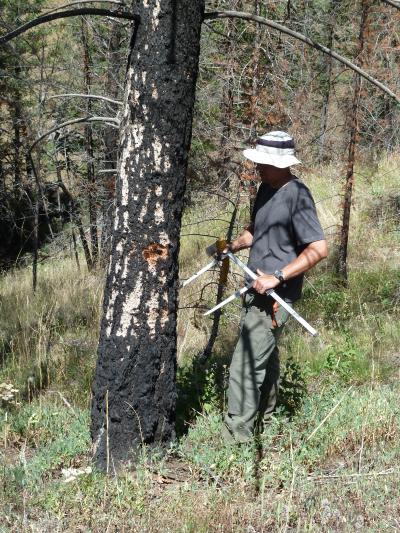CU study: Fires, drought in changing climate affecting high-altitude forests

CU-Boulder postdoctoral researcher Brian Harvey is collecting data on burn measurements and post-fire tree seedlings in a burned forest just outside of Yellowstone National Park. Credit: Brooke Weiland
For the study the team looked at nearly 200 subalpine forest plots that had undergone severe fires between 1994 and 2003 in and around Yellowstone National Park and Glacier National Park in Wyoming and Montana, said CU-Boulder postdoctoral researcher Brian Harvey.
Subalpine forest regions in the West are the dense forests just downslope from the alpine tundra, said Harvey of CU-Boulder's geography department who led the study while a graduate student at the University of Wisconsin-Madison.
The researchers found that the rate of post-fire tree seedling establishment decreased substantially with greater post-fire drought severity. Seedling establishment also decreased when the seed sources were at greater distances from the edge of burn patches, he said.
The team also found evidence that tree species from warmer and drier climates at lower elevations may colonize burned areas in subalpine forests as temperatures climb, but at rates lower than the decrease of current subalpine tree species, Harvey said.
“This study is a crystal ball of sorts that helps us to see what forest recovery may look like in the future following severe fires,” he said. “These forests are well adapted to severe fires, but the net result of larger fires and warmer temperatures will likely be a decrease in tree density, a reduction in forest extent, and more forest patchiness in high-elevation areas.”
A paper on the subject was published online in Global Ecology and Biogeography. Co-authors on the study include biologist Daniel Donato of the Washington State Department of Natural Resources in Olympia and Professor Monica Turner of the University of Wisconsin-Madison.
The team measured tree species, numbers, sizes and ages of post-fire tree seedlings in the high-altitude forest plots. They also measured the distance between each plot — which were roughly 100 feet in diameter — to the nearest tree seed sources, as well as charting drought severity in the three years following severe fires.
Each study plot was located in areas of severe wildfires that burned in 1994, 1999, 2000 and 2003, times of widespread fire across the Northern Rockies, said Harvey.
“Over the next century, large fire years followed by droughts at least as severe as those seen in recent decades will likely become a more regular occurrence in the U.S. Northern Rockies,” the authors wrote in Global Ecology and Biogeography.
Temperatures in the West have risen 2 to 3 degrees Fahrenheit in recent decades, which climate scientists attribute in large part to rising greenhouse gases in Earth's atmosphere as a result of human activity.
Seedlings of Engelmann spruce and subalpine fir, two common subalpine trees, decreased substantially in high elevations when coupled with fire and drought. But a third major subalpine species, lodgepole pine, was less affected, in part because of the abundant seeds stored in its cones that are released after fire events, said Harvey.
High-elevation forests in the western U.S. also can host Douglas fir, quaking aspen, western larch and whitebark pine. Both Yellowstone and Glacier have large amounts of of federally protected land, much of it wilderness, that allows natural tree regeneration after fires and makes the subalpine zone a living lab of sorts for researchers, he said.
“Data showing how forests may or may not recover following future fires in a warmer climate is extremely hard to get,” said Harvey. “Our approach was to look at recent fires that were followed by a range of climate conditions, with the warmer/dryer scenario the most likely window into what we might expect in the future.
“When we were collecting data for this study, we essentially were walking around on the front lines of climate change,” said Harvey.
###
The study was funded in part by the U.S. Joint Fire Science Program and the National Park Service. The study involved undergraduates, graduate students, postdoctoral researchers and faculty.
Contact:
Brian Harvey, 650-521-1988
brianjamesharvey@gmail.com
Jim Scott, CU-Boulder media relations, 303-492-3114
jim.scott@colorado.edu
Media Contact
All latest news from the category: Ecology, The Environment and Conservation
This complex theme deals primarily with interactions between organisms and the environmental factors that impact them, but to a greater extent between individual inanimate environmental factors.
innovations-report offers informative reports and articles on topics such as climate protection, landscape conservation, ecological systems, wildlife and nature parks and ecosystem efficiency and balance.
Newest articles

NASA: Mystery of life’s handedness deepens
The mystery of why life uses molecules with specific orientations has deepened with a NASA-funded discovery that RNA — a key molecule thought to have potentially held the instructions for…

What are the effects of historic lithium mining on water quality?
Study reveals low levels of common contaminants but high levels of other elements in waters associated with an abandoned lithium mine. Lithium ore and mining waste from a historic lithium…

Quantum-inspired design boosts efficiency of heat-to-electricity conversion
Rice engineers take unconventional route to improving thermophotovoltaic systems. Researchers at Rice University have found a new way to improve a key element of thermophotovoltaic (TPV) systems, which convert heat…



